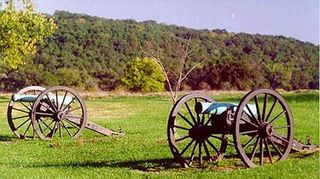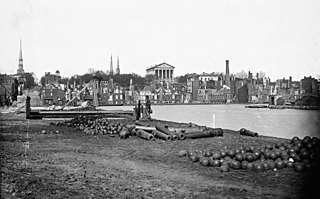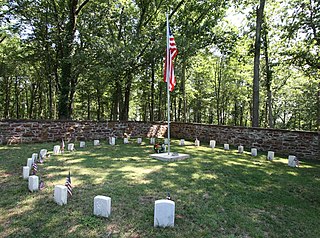
The Richmond–Petersburg campaign was a series of battles around Petersburg, Virginia, fought from June 9, 1864, to March 25, 1865, during the American Civil War. Although it is more popularly known as the siege of Petersburg, it was not a classic military siege, in which a city is encircled with fortifications blocking all routes of ingress and egress, nor was it strictly limited to actions against Petersburg. The campaign consisted of nine months of trench warfare in which Union forces commanded by Lieutenant General Ulysses S. Grant assaulted Petersburg unsuccessfully and then constructed trench lines that eventually extended over 30 miles (48 km) from the eastern outskirts of Richmond, Virginia, to around the eastern and southern outskirts of Petersburg. Petersburg was crucial to the supply of Confederate General Robert E. Lee's army and the Confederate capital of Richmond. Numerous raids were conducted and battles fought in attempts to cut off the Richmond and Petersburg Railroad. Many of these battles caused the lengthening of the trench lines.

Fort Pillow State Historic Park is a state park in western Tennessee that preserves the American Civil War site of the Battle of Fort Pillow. The 1,642 acre (6.6 km²) Fort Pillow, located in Lauderdale County on the Chickasaw Bluffs overlooking the Mississippi River, is rich in both historic and archaeological significance. In 1861, the Confederate army built extensive fortifications and named the site for General Gideon Johnson Pillow of Maury County. It was attacked and held by the Union Army for most of the American Civil War period except immediately after the Battle of Fort Pillow, when it was retaken by the Confederate Army. The battle ended with a massacre of African-American Union troops and their white officers attempting to surrender, by soldiers under the command of Confederate Major General Nathan Bedford Forrest.

The Tredegar Iron Works in Richmond, Virginia, was the biggest ironworks in the Confederacy during the American Civil War, and a significant factor in the decision to make Richmond the Confederate capital.

Wilson's Creek National Battlefield, located near Republic, Missouri, preserves the site of the Battle of Wilson's Creek. Fought on August 10, 1861, the battle was the first major American Civil War engagement west of the Mississippi River. In the battle, a Confederate army commanded by Benjamin McCulloch and Sterling Price defeated a smaller Union army commanded by Nathaniel Lyon. However, the Confederates were unable to hold much of Missouri, and a Confederate defeat at the Battle of Pea Ridge effectively solidified Union control of the state. Major features include a five-mile automobile tour loop, the restored 1852 Ray House, and "Bloody Hill", the site of the final stage of the battle. The site is located near Republic in southwestern Missouri just southwest of the city of Springfield. It has been a unit of the National Park Service since 1960, and was listed on the National Register of Historic Places in 1966.

The Richmond National Battlefield Park commemorates 13 American Civil War sites around Richmond, Virginia, which served as the capital of the Confederate States of America for most of the war. The park connects certain features within the city with defensive fortifications and battle sites around it.

Fort Pocahontas was an earthen fort on the north bank of the James River at Wilson's Wharf, in Charles City County, Virginia which served as a Union supply depot during the American Civil War. The fort was constructed by African-American soldiers of the United States Colored Troops under the command of Brig. Gen. Edward Augustus Wild.

Cedar Creek and Belle Grove National Historical Park became the 388th unit of the United States National Park Service when it was authorized on December 19, 2002. The National Historical Park was created to protect several historically significant locations in the Shenandoah Valley of Northern Virginia, notably the site of the American Civil War Battle of Cedar Creek and the Belle Grove Plantation.

Richmond, Virginia, served as the capital of the Confederate States of America during the American Civil War from May 1861 to April 1865. Besides its political status, it was a vital source of weapons and supplies for the war effort, as well as the terminus of five railroads; as such, it would have been defended by the Confederate States Army at all costs.

Robert Boisseau Pamplin Jr. is an American businessman, philanthropist, and minister. He is also noted as an educator, historic preservationist and author.

Perryville Battlefield State Historic Site is a 745-acre (3.01 km2) park near Perryville, Kentucky. The park continues to expand with purchases of parcels by the Office of Kentucky Nature Preserves' Kentucky Heritage Land Conservation Fund and the American Battlefield Trust. An interpretive museum is located near the site where many Confederate soldiers killed in the Battle of Perryville were buried. Monuments, interpretive signage, and cannons also mark notable events during the battle. The site became part of the Kentucky State Park System in 1936.

High Bridge is a historic former railroad bridge across the Appomattox River valley about 6 miles (9.7 km) east, or downstream, of the town of Farmville in Prince Edward County, Virginia. The remains of the bridge and its adjacent rail line are now a rail trail park, High Bridge Trail State Park.

Ball's Bluff Battlefield Regional Park and National Cemetery is a battlefield area and a United States National Cemetery, located 2 miles (3.2 km) northeast of Leesburg, Virginia. The cemetery is the third smallest national cemetery in the United States. Fifty-four Union Army dead from the Battle of Ball's Bluff are interred in 25 graves in the half-acre plot; the identity of all of the interred except for one, James Allen of the 15th Massachusetts, are unknown. Monuments to fallen Confederate Sergeant Clinton Hatcher and Union brigade commander Edward Dickinson Baker are located next to the cemetery, though neither is buried there. While the stone wall-enclosed cemetery itself is managed through the Culpeper National Cemetery and owned by the Department of Veterans Affairs, the balance of the 223-acre (0.90 km2) park is managed through the Northern Virginia Regional Park Authority.

Five Forks Battlefield is a battlefield of the American Civil War, the location of the Battle of Five Forks, in which Union Army forces broke through Confederate Army lines, opening the way to gain control of the last rail line to besieged Petersburg. The Confederate loss caused them to abandon that city, which undermined the defense of Richmond, the Confederate capital. Final surrender of the Confederate forces would occur at Appomattox Courthouse eight days later.

The Petersburg Breakthrough Battlefield is a historic district in Dinwiddie County, near Petersburg, Virginia. It was the location of the Third Battle of Petersburg, in which the Union Army broke through Confederate Army lines protecting Petersburg and Richmond on April 2, 1865, during the American Civil War. The success of the breakthrough led to abandonment of Richmond by General Robert E. Lee, a general retreat, and surrender at Appomattox Court House one week later. Portions of the area were listed on the National Register of Historic Places in 2003, and a different portion was designated a National Historic Landmark in 2006. Much of the battlefield area is part of Pamplin Historical Park, a private park open to the public that interprets the battle. The park includes a full-service visitor center, trails, displays, interpretive signs and history programs. The Civil War Trust and its partners have acquired and preserved 407 acres (1.65 km2) of the Breakthrough battlefield in five transactions since 2004.

Sayler's Creek Battlefield, near Farmville, Virginia, was the site of the Battle of Sayler's Creek of the American Civil War. Confederate general Robert E. Lee's army was retreating from the Richmond to the Petersburg line. Here, on April 6, 1865, Union general Philip Sheridan cut off and beat back about a quarter of Lee's depleted army. Eight Confederate generals surrendered, and 7,700 men were lost. Confederate Major General George Washington Custis Lee, eldest son of Robert E. Lee, was forcibly captured on the battlefield by Private David Dunnels White of the 37th Massachusetts Regiment. The battle was the last major engagement of the war in Virginia; Lee's surrender at Appomattox occurred three days later. A portion of the landmarked battlefield area is included in Sailor's Creek Battlefield Historical State Park. The Civil War Trust and its partners have acquired and preserved 885 acres (3.58 km2) of the battlefield in five transactions since 1996.

Sailor's Creek Battlefield Historical State Park is a 379-acre (153 ha) state park near Rice, Virginia, located mostly in Amelia County with a small portion in Prince Edward County. It includes a portion of the landmarked Sayler's Creek Battlefield, an area of 1,022 acres (414 ha) that was the site of the April 6, 1865 Battle of Sayler's Creek, one of the last major engagements in the Eastern Theater of the war involving Confederate General-in-Chief Robert E. Lee (1807–1870). The battle occurred during his week-long retreat to the southwest in the final Appomattox campaign from the fallen Confederate capital at Richmond and nearby Petersburg, three days before his surrender at Appomattox Court House to Union Army General-in-Chief Ulysses S. Grant (1822–1885), which effectively ended the American Civil War (1861–1865).
Don Troiani is an American painter whose work focuses on his native country's military heritage, mostly from the American Revolution, War of 1812 and American Civil War. His highly realistic and historically accurate oil and watercolor works are most well known in the form of marketed mass-produced printed limited-edition reproductions, illustrated books, book compilations, museum and government collections. He is also a militaria collector.
The National Museum of the Civil War Soldier, part of Pamplin Historical Park, is located in Petersburg, Virginia. A Civil War museum that has won a number of US and international awards and recognition, the museum is Duty Called Me Here as well as The Civil War Store, The Pamplin Board Room, and the Remembrance Wall. Duty Called Me Here is an exhibit that comprises seven galleries to allow to visitors to meet the 3 million soldiers who served during the Civil War using videos, computers and life-size dioramas, including the multi-sensory battlefield simulation, "Trial By Fire," designed originally by award-winning experience designer Bob Rogers (designer) and the design team BRC Imagination Arts. It is a complement to the Remembrance Wall, which contains the names of those who served during the War. The museum does this without delving into the political issues of which side the soldiers were on.
The Civil War Trust's Civil War Discovery Trail is a heritage tourism program that links more than 600 U.S. Civil War sites in more than 30 states. The program is one of the White House Millennium Council's sixteen flagship National Millennium Trails. Sites on the trail include battlefields, museums, historic sites, forts and cemeteries.

Allen Wilson Greene, also known as Will Greene, is an American historian, author, and retired museum director. Greene was the director of the Association for the Preservation of Civil War Sites. Later, he became director of Pamplin Historical Park and the National Museum of the Civil War Soldier in Petersburg, Virginia. He also served on the national oversight board for the Institute of Museum and Library Services Over the years, Greene has made ten appearances on C-SPAN.





















